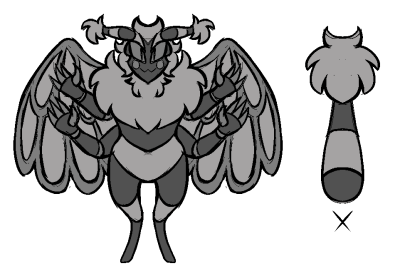Comber
Name: Comber
Creator: Fallow
Home Zone: Fallow's Island
Project Appearances: TBA
Species Development Thread: Species Development: Combers
Table of Contents
Combers are an insectoid species based on various eusocial, winged insects that originate on the Fallow's Island of the Luxson Cluster.
Origin
Combers were created by Fallow on its island, the first morph being the adventurer morph.
Culture
Primarily found in Luxson, though some remain in Fallow’s Island post-Horror Plague. A significant amount of combers can be found in Monte, and have distributed to non-Luxson Cluster regions readily and in significant numbers.
While they are associated with Fallow by many, combers are far less readily tied to it than the other species native to its island. They are more prone to wandering and consider themselves less tied down to anyone god, though some do keep to the island’s traditions.
Most combers count themselves as followers of Fallow, though Anne came a close second before her disappearance. Those numbers have dwindled severely since, and now XXI and Stope make up the middling numbers. Combers outside of Luxson take up regional worship.
Due to mass exposure to horror during the Luxson Horror Plague, a large portion of the comber population native to the Luxson Cluster has horror-related conditions and/or mutations, though these are often managed with medications and other treatments.
Combers 40 years or older living in the Luxson Cluster have a higher chance of having damaged wings, battle scars/injuries, and/or prosthetics from the Luxson Horror Plague. Most combers avoided fighting on the field due to their fragility compared to centinels and masques, but any comber over 20 years old in the Cluster is still likely to have some physical or psychological impact from the plague.
Combers are easily susceptible to overwork-related conditions due to their tendencies to overfocus on tasks and goals. This tendency resulted from Fallow’s intent of creating a species that could help keep its society more structured, only to have it backfire when not managed by sufficient social and health programs. Unfortunately, the majority of those in Fallow’s Island fell when the plague hit, though Luxson is trying to pick up the slack. Combers in zones outside of Luxson or Fallow’s Island are especially prone to mental health issues if not given specialized care for their overwork and focus tendencies.
Combers were designed with a fantasy theme for their morphs, and many choose to embrace that- comber goods are often designed with those artistic motifs in mind, and can look 'magical' even if meant for completely normal, everyday use. These are often mistaken for scrap tools by the unfamiliar, and some comber-oriented merchandisers are often accused of scamming the market.
Combers prefer enclosed sleeping situations, with canopies and capsule-hotel-style beds being common modern solutions.
Comber blood is considered extremely valuable both to combers for its cultural value, and other species that consider it a delicacy.
Combers often create capes for other species inspired by their wing shapes and patterns. These items are very popular.
Comber culture preferred either classical Fallow’s Island group classes or formal education for their young when available under Anne’s rule, but since the Horror Plague, many in the Luxson Cluster have had to adjust to the apprenticeship system XXI promotes.
Combers, like other Fallow’s Island species, often prefer to live in housing with other people, but unlike other Fallow’s Island species, do not necessarily need large amounts of space to themselves, and are fine with small apartments or even the aforementioned capsule hotel-style living if accommodations are nice enough.
Fashion made for other species typically has to be modified to fit a comber’s wings and second pair of arms. Combers are completely capable of flight, and are free to do so on Fallow’s Island- doing so in other zones can cause distress and confusion to those around them, so many avoid it or keep such activity to themselves.
Combers are not particularly skilled in combat on an inherent level, though some morphs have horns, claws, and/or spikes. When forced to fight, combers will either use the aforementioned features if present or their teeth, or, more likely, use a weapon or fly away.
The comber tendency to focus on completing tasks makes video games with easily completed objectives a particularly compelling draw, for better or for worse. It can be an extremely satisfying way for combers to spend time and relieve stress, but can equally absorb time and take away from the rest of their lives.
Traditional comber entertainment involves puzzles and riddles, things that engage the mind and attention. These range from simple games for fun to complex brain teasers that take weeks to unravel, and while they don’t suit every comber’s taste, many find them particularly engaging and a good way to ease the focus tendencies.
Appearance
Combers have no uniform body shape, with the form of their body varying based on their morph.
Their fur shapes depend on morph, with some having rounded, soft fluff and others having rougher fur.
Their markings vary, but typically involve bands of some sort.
Comber voices consist of beeping and buzzing.
They lack paw pads.
Comber tails are banded and tipped in some way, typically with some kind of tuft or spiked stinger.
Combers do not typically have hair, but it occurs at an uncommon rate.
Combers range from 3’6-5’6 at a “normal” adult height range, though some morphs do skew larger.
Combers have four arms and digitigrade legs.
Biology
Combers have skeletons, muscles, nerves, and organs.
Comber blood is thick and honey-like in consistency and color and is often considered culturally important by combers themselves, and a delicacy by other species. This blood hardens when left outside of the body, leading many combers to let it sit in molds and form a sort of candy, meant to be used as gifts or currency in the olden days. This blood naturally oozes from the body with no harm necessary during the full and new moon cycles, typically from the tips of their tails and antennae.
They have sharp teeth and are mainly omnivorous, though they particularly enjoy nectar and sap from plants.
Combers are a moderately active species, with average energy levels.
Combers make heavy use of their antennae and tail when emoting, along with the use of their hands.
They typically have large eyes with typically black pupils.
Their wings are fragile and can be torn.
Life Cycle/Family Structure
Combers typically have a lifespan of 100 years, reach maturity at 18-20 years old.
They reproduce sexually and have minimal sexual dimorphism.
Combers lay eggs in clutches of 3-5 at a time. Their children are known as kids and resemble caterpillars until they hit a period of adolescence, typically around 13 years old, at which point they form a cocoon and go dormant for up to a year before emerging as a comber. They are still considered children until age 18, however. Comber kids are prone to accidents with flying until their wings fully develop and require special instruction. Orphaned comber kids are in great danger due to their vulnerable dormancy period, making rehoming them, even with other species, a necessity for survival. Proper nutrition and safety is required for a comber kid to cocoon, and those who don’t either evolve into [undeveloped morph] or die.
Comber families often incorporate members of other species and can get quite large. Blood ties are typically not necessary, and furthermore, having chosen family is more common.
Casual and committed relationships are equally valued, but committed relationships are more frequent, likely due to their tendency to focus on certain things for extended periods of time.
Leaving the family is considered a decision to be taken very seriously, but is encouraged as long as a plan is made by adulthood/late teens.
Genetics
Comber morphs are inspired by types of bees and fantasy creatures.
Mixed morph children often take blended traits in the form of antennae shape, eye shape, tail length/thickness, and wing thickness.
The first morph created by Fallow was the adventurer morph.
Comber hybrids typically have the potential to take on wings, manes, banded markings, honey blood, and/or antennae.
Common comber mutations include; claw/teeth growth, antennae growth, spike growth, stinger growth, honey blood becoming toxic, focus tendency becoming worse/more intense, mood instability, hunger increase, size increase, and extra tails.
Morphs
Adventurer
The adventurer morph is based on honey bees and fantasy protagonists. They have curved antennas with fluffy tufts, rounded fluff, a tufted tail, rounded wings, and a large mane around their chest. They are associated with Fallow's Island. Adventurer morph combers are often drawn to taking up a singular “calling”, sometimes likened to a personal “quest”. These callings can take any form and can be either specific or vague. Callings can never truly be completed and are goals the adventurer comber strive towards as well as use to shape their lifestyle.
Challenger
The challenger morph is based on wasps and dragons. They have horn-like antennas with rough tufts, rough fluff, bat-like wings, spiked tail, a large mane around their chest, scales on their carapace, claws, and occasional spikes on their body. They are associated with Fallow's Island. Challenger morph combers are often drawn to collecting objects, sometimes specific types and other times broad categories. These items are often carefully maintained and treasured by the challenger comber. Some challenger combers have taken advantage of this inclination in their careers, taking positions as museum curators or warehouse managers.
Keeper
The keeper morph is based on bumblebees and Cerberus. They have three heads that do not inherently share or have independent consciousness, with each keeper comber having a unique level of plurality. They are associated with Luxson. Keeper morph combers are often drawn to selecting a location as their “Haven”. This can be their home, workplace, local haunt, etc. Keeper morph combers tend to maintain their haven meticulously and feel the urge to protect it from threats that would disturb it and those who frequent it.
Messenger
The messenger morph is based on hornets and unicorns. They have a single horn in the center of their head, claws, and a heraldic tail. They are associated with Monte. Messenger morph combers are often drawn towards the mysterious, unseen, and unknown, be it the discovery and unmasking of it or becoming a part of it. Many messenger combers dabble in conspiracy or research, and they often become vast repositories of information due to this. Though how focused this information is depends entirely on the individual messenger comber.
Riddler
The riddler morph is based on leafcutter bees and sphinxes. They have feathery wings, a tufted tail, and a large mane around their chest. They are associated with Fallow's Island. Riddler morph combers are drawn towards brain teasers, puzzles, riddles, and philosophical quandaries. Riddler morph combers tend to interject conversations with such puzzles, the relevance usually only revealed after the question has been sufficiently addressed by those conversing.













